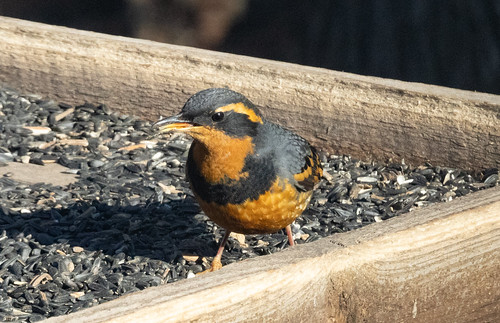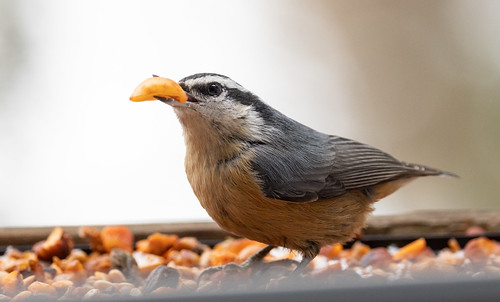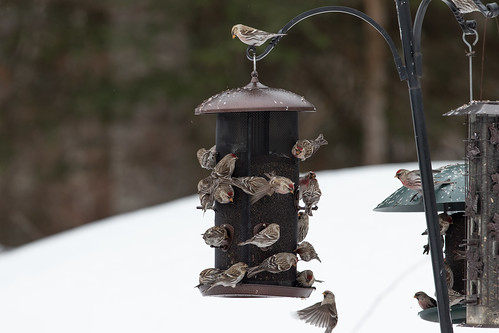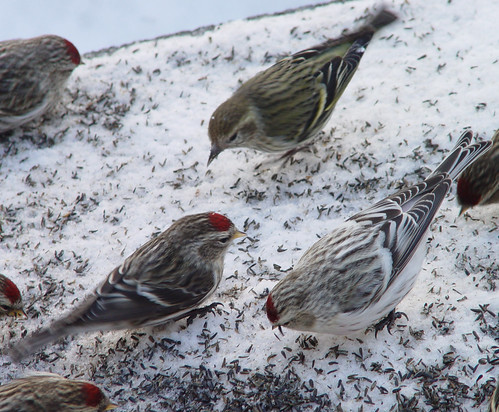The first thing most people think of when they hear “bird feeding” is bird seed. But there are many kinds of bird seed, some much better than others. The basic mixtures sold at many stores may be less expensive than bags of sunflower or white millet but are not economical—you’re paying much more per pound for the seeds birds actually eat. The rest is cheap filler, which mostly goes uneaten, rotting to eventually contaminate the good seed. As far as cheap bird seed mixtures go, just say no.
I do buy one seed mixture, called Fiery Feast, but it’s very expensive—I only use it in my small office window feeder. It contains sunflower chips, tree nuts and peanut parts, all laced with capsaicin pepper. Woodpeckers seem to find the spicey taste appealing. I've had Pileated and Red-bellied Woodpeckers and Northern Flickers in my window feeder since switching to Fiery Feast.
Pepper plants have evolved to attract birds while triggering pain sensors in mammal mouths, because healthy birds are the animals that most effectively disseminate pepper seeds. My other feeders have squirrel baffles, but squirrels can easily jump into my window feeder from a couple of different directions on my roof and from my nearby spruce tree. Just tasting the seed is bad enough for them, but apparently standing in it gets enough capsaicin on their feet or belly fur that I think they get a painful reminder when they groom themselves, because it didn’t take many visits for them to stay completely away. Don’t feel too sorry for my squirrels—I put plenty of peanuts out for them every morning.
 |
| I count 24 Blue Jays crowded into this feeder with black oil sunflower! |
The single seed that appeals to the most birds and is most nutritious is sunflower. The type most people are familiar with because it’s grown for human consumption is called linoleic, and has a thick, striped shell. Long ago, this was the type most often sold for bird feeding, too, so packaging seldom used to specify what type of sunflower seed it was.
 |
| This Varied Thrush visited a friend's feeder for black oil sunflower seeds. I think striped sunflower would be too hard for it to open. |
The type of sunflower grown primarily for pressing the seeds to extract sunflower oil, usually called “black oil sunflower seed,” started being used more and more for bird feeding in the 1980s. This type has more fat than the white-striped type. Birds metabolize oils and fats better than we humans do, and especially in winter, when calories for fuel are essential, black oil sunflower seed is ideal, but it’s also excellent year-round. Black oil sunflower seed has a thinner, easier-to-open shell than striped sunflower seed, meaning birds expend fewer calories eating it. Chickadees, grosbeaks, and finches can easily open either kind, but blackbirds and House Sparrows have a much easier time with the softer shells of black oil seeds. Where these are a problem, it can be wiser to find striped sunflower seeds.
Because sunflower shells of either type are not edible and collect in and under feeders, feeding sunflower seeds involves cleanup. As the shells collect and thaw, even for short periods, they begin to rot, fostering disease organisms which contaminate fresh seed, too. This can sicken birds, especially those feeding on the ground. Siskins and redpolls are particularly susceptible—every April we start getting serious warnings about bird feeding because of this. It’s irresponsible to feed sunflower in winter without shoveling or raking out the shells, especially as snows thaw.
But what do we do with those moldy shells? Sunflower seed shells contain alleopathic compounds which are toxic to grasses and most cultivated garden plants, so they shouldn’t be mixed in with compost we’re planning to use for our gardens unless we have a lot of better yard and food waste to mix in. And no matter how we dispose of it, we need to keep birds out. In most urban areas, including Duluth, people are supposed to keep compost enclosed to keep rats out. That works to keep birds out, too.
To avoid all the work involved with disposing of shells, or in apartment complexes or other situations where there are rules about bird feeding, many people use sunflower seeds that were already taken out of the shells, called sunflower chips or hearts. These are a main ingredient in many “no mess” bird feeding mixtures and are very popular with birds, but without the shell, they’re susceptible to rot, so it’s important not to put out more than birds can eat in a day or two, especially during wet weather.
Besides black oil sunflower seeds, I buy two other kinds of bird seed. Nyjer seed, often called thistle, is great for finches but expensive. It’s not native to America and to prevent it from becoming a noxious week, it’s heated at high temperatures so it won’t germinate. If it’s heated too long, birds hardly touch it. Buying it in clear bags so you can make sure the seeds are shiny black may help you identify bags birds are more likely to eat. I have a couple of Nyjer tube feeders, which have very tiny holes compared to other tube feeders, and also pour a small amount on my platform feeders when I have a lot of redpolls, siskins, or goldfinches visiting. I mostly fill those feeders with sunflower, which helps keep the Nyjer in the feeder, though a bit does work its way through the screened bottoms. Since the birds that eat Nyjer feed on the ground as much as they do in feeders, they seem to use it up as fast as it collects, but we rake or shovel beneath those feeders anyway as sunflower shells collect.
Juncoes and other native sparrows feed heavily on white millet. I used to scatter that on the ground in a few places where these birds gather, and I'd still be doing that if I lived in an isolated spot in the woods.
But ever since rats invaded our neighborhood, I’ve stopped doing setting out bird food on the ground. I pour a bit of millet on my platform feeders each morning when I have a lot of juncos, as I do this winter. My platform feeders have screened bottoms, so some tiny seed falls through to the ground, but it’s a small amount that seems to get eaten up quickly by the juncos eating beneath.






